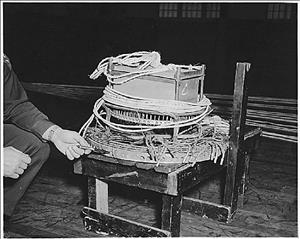On February 12, 1945, the first of 28 incendiary balloons launched from Japan and known to land in Washington are discovered seven miles north of Spokane. Two unexploded bombs are discovered and neutralized. As many as 9,000 balloons have sent aloft from the Japanese island of Honshu beginning in November 1944 to set forest fires, which would siphon manpower and resources away from the war effort. There are few fires and no one is injured in Washington. A woman and five children on a church outing will be killed by one device near Klamath Falls, Oregon, on May 5, 1945.
Airborne Retaliation
Beginning in 1933, the Imperial Japanese Army experimented with free-floating balloons that could carry bombs against the enemy. In September 1942, this became Operation "Fugo" (Wind Ships), intended as retaliation for the April 1942 Doolittle Raid in which American bombers struck the Japanese home islands for the first time. The Japanese military planned to take advantage of high-altitude air currents, then largely unknown to U.S. scientists.
The Imperial Japanese Navy developed a rubberized silk balloon and the Army came up with a paper model made up of 600 panels assembled by schoolgirls. An incendiary device was suspended below the envelope. Inflated balloons were sent aloft to catch the jet stream and were maintained at altitude with barometer-operated valves to release hydrogen and blow-plugs to release bags of sand. By the time the gas and ballast were exhausted, it was hoped the balloons would be over North America and the bombs would drop to earth. Both incendiary and anti-personnel devices as well as infantry mortar shells could be used.
The first bomb-carrying balloons were set aloft on November 3, 1944, and the first sightings in U.S. territory came soon thereafter. The first two of the 28 balloons eventually discovered in Washington were found seven miles north of Spokane on February 12, 1945. More Washington sightings followed. At least three balloons were found in Yakima County. Children in Moxee and Wapato played with balloons, and a shepherd from Moxee dragged one home behind his car. None of them were injured. Those who found the balloons were unlikely to know they were bombs. News sources generally refrained from reporting any of the balloons to prevent the Japanese from learning where balloons were landing or whether they worked, although scattered reports popped up in local papers and in Time magazine.
Six Casualties
On May 5, 1945, Pastor Archie Mitchell (1918-1969?), his wife Elsie (or Elyse) Winters Mitchell (1919-1945) of Port Angeles, and five children from their church in Bly, Oregon, were on a picnic on Gearhart Mountain not far from Klamath Falls. Elsie Mitchell and the children discovered one of the explosive devices while Reverend Mitchell was parking their car. Moments after she called him to come see what they had found, the bomb exploded, killing Elsie Mitchell, Sherman Shoemaker (1934-1945), Edward Engen (1931-1945), Jay Gifford (1932-1945), Joan Patzke (1931-1945), and Dick "Joe" Patzke (1930-1945).
Balloons, bombs, and fragments turned up all over the western U.S., Canada, and Alaska, 342 incidents in all. Some balloons were shot down by fighter planes or ground forces. Probably the most serious damage in Washington occurred on March 10, 1945, when a balloon hit power lines and temporarily blacked out the secret nuclear weapon works at Hanford. After the war, people found more evidence of the Fugo campaign. On March 4, 1949, Grays Harbor Sheriff's Deputy Mike Kilgore found the remains of one device near Montesano. He turned his find over to U.S. Navy authorities.
With no evidence of success (a lack of evidence helped by the news embargo on bomb sightings), Japanese officials scrapped the program. Except for the deaths in Oregon, no casualties, fires, or serious destruction were attributed to the balloons. The campaign did prove problematic for U.S. and Canadian forces, which had to redeploy air defense and other assets to chase balloons.

